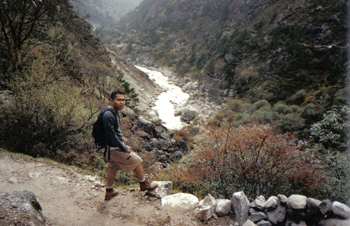|
||||
|
||||
Everybody talks about the "big Namche" hill as being the tough one, but for me it's the Thyangboche hill. You drop way down — to say 10,500 feet — to cross the Dudh Kosi one more time, then have to gain more than 2,000 feet of elevation up to the monastery. The trail works up through the pine forest from the river, relentlessly steep and long as it angles upward. I get real lucky and see a tahr, a wild Himalayan goat with peculiar curved horns, standing on a rock watching me go by, and shortly after that an incredible wild peacock bobbing through the undergrowth. All this was just beyond funky Phunki Tenga, a village known for its multiple water-wheel-powered prayer wheels. The
antidote to the bummer afternoon costs 180 rupees and comes in a bottle:
San Miguel beer. |
||||
| A local in deep prayer | ||||
Farther up the hills I almost stumble on a dead yak lying in the middle of the trail. Its tongue sticks out, eyes distended, only a day or two gone. The saddle, bell and harness have been removed, its load too. The dead beast of burden makes a sad sight for me, harsh, but it's just life and death in a place where nothing is sanitized. I plod on toward the monastery. I've been reading about Thyangboche ever since I was a kid, but my arrival here after all these years is a let-down. The weather's been overcast all day, depressing, a gray cloud laden with rain, but by the time I arrive on the ridge there's a full-on white-out that soon turns to an energetic snowstorm. So much for the famous view. Click here to see an enlargement. Nobody wants to camp in the crummy weather, so we're back in a tea house. The antidote to the bummer afternoon costs 180 rupees and comes in a bottle: San Miguel beer, carried laboriously by somebody or somebody's yak up from Kathmandu. We gather around the stove and drink and tell stories. There's an Australian woman staying at the tea house who talks really loudly to her Sherpa guide and anyone else who'll listen, and an American woman on her way back to Kathmandu. They eye us suspiciously as our kitchen staff brings us snacks — cheese, crackers, a big bag of pistachios. Nobody is unfriendly, it's just that it takes too much energy to make pals out of everybody. The parallel conversations continue on opposites sides of the room. I'm awakened in my absurd cubicle by the sound of strange chants, horns and gongs. Freddy Blume snores away, oblivious, but my interest is piqued. Looking out the lodge window I can see a couple of red-robed, head-shaved monks actually hanging out a second-floor window of the monastery, shouting in that strange way they have, blowing those Bronx-cheer horns and banging a small gong. The sky is a crystalline blue, and I'm thinking this could be good. It looks
like what a Buddhist monastery high in the Himalaya should look like. Click here to see an enlargement. Later that day the rinpoche of the monastery, the head holy man, agrees to see and bless the members of the expedition. We're first led into the ornate main hall of the monastery, elaborately painted in Buddhist motifs and dominated by the two story high Buddha. It looks like what a Buddhist monastery high in the Himalaya should look like. A monk hands each one of us khatas, into which we put a couple of hundred rupees and fold them up. Everyone antes up, it would make no sense to gyp the rinpoche when he's offered to bless the hazardous climb ahead. Next we are lead by a monk into a small chamber where the rinpoche sits at a throne-like chair behind a spindly, ornate table. Two old but clearly subservient monks sit on cushions before him. One by one, the rinpoche greets us, takes the khatas from us, and shakes each one until the rupee notes fall out on us and then to the floor. The rinpoche then places the khata around our necks. Next he produces some red string, blows on it, and another monk ties it around our necks. The rinpoche then claps his hands sharply, twice, and we are dismissed. |
||||
 |
||||
| A local in deep prayer | ||||
Sagamartha NP Hq. is strongly recommended, as it offers well displayed information on the history and culture of the Everest region as well as spectacular views of the Everest massif. If you wish, you may imply relax and enjoy the 'luxuries' of Namche - cold beer, chocolates hot cinnamon rolls etc. You will probably want to stock up here for the next stage of the trek, as above Namche there is little to buy. Click Next |
||||

